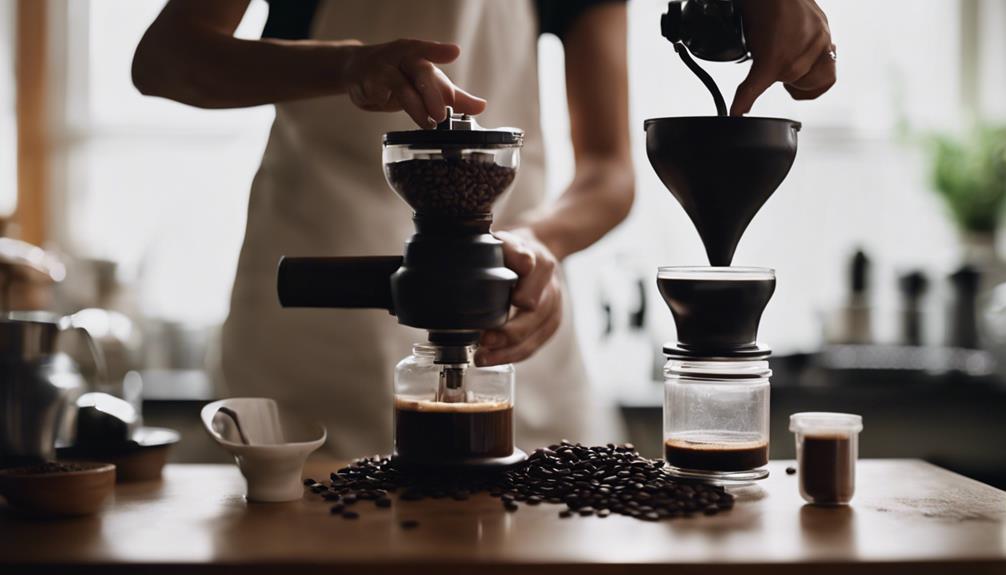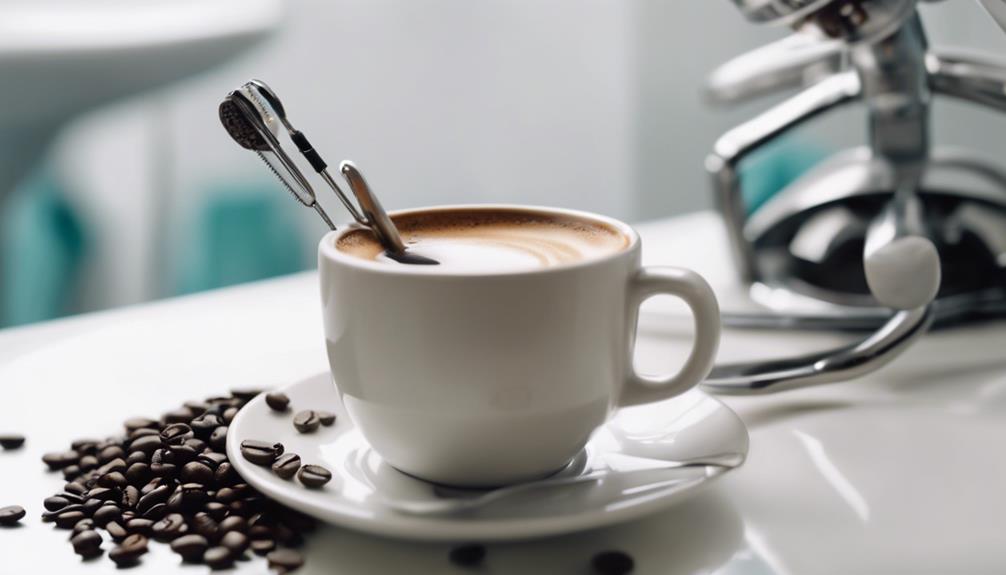Coffee enemas have the potential to disrupt the balance of gut bacteria, which can lead to Small Intestinal Bacterial Overgrowth (SIBO). Introducing coffee into your system may throw off the harmony of your gut bacteria, allowing harmful bacteria to thrive over beneficial ones. This imbalance can interfere with the absorption of essential nutrients and eliminate beneficial bacteria, worsening SIBO symptoms. Prolonged use of coffee enemas without probiotic support could exacerbate your condition. To fully understand how coffee enemas can affect SIBO and to receive expert recommendations, it is crucial to consider consulting healthcare professionals who are familiar with your specific health needs. For more information, you can visit a site for the best organic coffee for enemas.
Key Takeaways
- Coffee enemas can disrupt gut bacteria balance, potentially leading to SIBO.
- Caffeine in enemas can flush out beneficial bacteria, worsening SIBO symptoms.
- Excessive caffeine disrupts gut health, exacerbating bacterial overgrowth in SIBO.
- Consult a healthcare professional before coffee enemas, especially for SIBO individuals.
- Long-term use without probiotic support may harm gut health, increasing SIBO risk.
Potential Impact on Gut Microbiome
Coffee enemas can disrupt the balance of gut bacteria, potentially leading to Small Intestinal Bacterial Overgrowth (SIBO).
The introduction of coffee into the colon through enemas has the potential to disturb the delicate ecosystem of bacteria residing in your gut. This disruption can create an environment where harmful bacteria thrive, potentially causing an overgrowth in the small intestine, known as SIBO.
When the balance of bacteria in the gut is altered, it can lead to various digestive issues and hinder the absorption of essential nutrients from food. Additionally, the caffeine present in coffee enemas can stimulate bowel movements, which may flush out beneficial bacteria along with waste material.
If you use coffee enemas long-term without proper probiotic support, you may exacerbate SIBO symptoms. It's important to consult with a healthcare provider before incorporating coffee enemas into your routine, especially if you're already dealing with concerns related to SIBO.
Prioritizing the health of your gut microbiome is essential for overall well-being and digestive health.
Caffeine and Gut Health Connection

Excessive caffeine consumption, particularly from coffee enemas, can have a significant impact on your gut health, potentially leading to disruptions in gut motility and increased intestinal permeability. Caffeine's stimulatory effect on the gastrointestinal tract can be particularly problematic for individuals with Small Intestinal Bacterial Overgrowth (SIBO), as it may exacerbate symptoms like bloating, gas, and abdominal discomfort. This heightened sensitivity to caffeine in those with SIBO can further contribute to bacterial overgrowth in the small intestine, worsening the condition.
To help you understand the relationship between caffeine and gut health, take a look at the table below:
| Fact | Description |
|---|---|
| Caffeine and Gut Motility | Caffeine can alter gut motility, potentially leading to digestive issues. |
| Caffeine and Intestinal Permeability | Excessive caffeine intake may increase intestinal permeability, impacting gut health. |
| Caffeine Sensitivity in SIBO | Individuals with SIBO may experience worsened symptoms due to the stimulatory effects of caffeine. |
| Consult Healthcare Provider | It's vital for those with SIBO to seek medical advice before considering coffee enemas to prevent symptom aggravation. |
Liver Detoxification Benefits

Coffee enemas can notably benefit liver detoxification by enhancing bile flow and boosting glutathione activity, a potent antioxidant.
The caffeine in these enemas aids in widening blood vessels in the liver, facilitating the removal of toxins and waste materials effectively.
Utilizing coffee enemas for liver detoxification can help alleviate the body's toxic load, ultimately supporting essential bodily functions and overall well-being.
Liver Detox Process
Boosting the liver's detoxification process can greatly benefit overall health and well-being. Coffee enemas play a significant role in stimulating the liver's detox function by increasing bile flow and enhancing the activity of glutathione, a potent antioxidant.
Through this process, toxins, heavy metals, and waste products are efficiently removed from the body, promoting detoxification and cleansing. The caffeine present in coffee enemas aids the liver in releasing stored toxins, further supporting the overall detox process.
By facilitating the liver's ability to process toxins effectively, coffee enemas can enhance one's health and well-being. This improved detoxification function not only benefits the liver but may also indirectly support gut health by reducing the toxic load on the body.
Incorporating coffee enemas as a means to boost the liver's detox process can have positive implications for your overall health and wellness.
SIBO Risk Factor
Stimulating the liver's detoxification process through coffee enemas can play a significant role in reducing the risk factors associated with SIBO. By enhancing bile release and boosting glutathione activity, coffee enemas support the liver in effectively removing toxins from the body, which may help prevent SIBO development.
The improved detox pathways facilitated by coffee enemas can reduce toxin buildup, potentially lowering the likelihood of SIBO occurrence. Additionally, the cleansing effect of coffee enemas on the blood can indirectly impact gut health, further decreasing the risk of SIBO.
Better digestion and nutrient absorption resulting from coffee enemas also contribute to overall gut health, potentially alleviating factors that can lead to SIBO. While the liver support and detox benefits of coffee enemas are evident, individuals with SIBO should seek advice from a healthcare professional before incorporating them to ensure compatibility with their specific condition.
Colon Cleansing Effects

Coffee enemas, through their colon cleansing effects, can disrupt the delicate balance of gut bacteria, potentially increasing the risk of bacterial overgrowth like SIBO.
The flushing out of beneficial gut bacteria by these enemas may compromise colon health, weakening the intestinal barrier and paving the way for SIBO development.
When considering the impact of enemas on your gut, it's crucial to be aware of how colon cleansing can influence the risk of bacterial overgrowth and overall gut health.
Enema Impact on Gut
When considering the impact of enemas on the gut, it's important to understand the potential effects of colon cleansing with coffee solutions.
The colon cleansing effects of coffee enemas can disrupt the delicate balance of bacteria in the gut, potentially flushing out not only toxins but also beneficial bacteria essential for gut health. This alteration in the gut microbiome can have implications for overall digestive health.
Individuals with small intestinal bacterial overgrowth (SIBO) may experience exacerbated symptoms when utilizing coffee enemas due to the disturbance caused to gut bacteria. It's essential to weigh the benefits of detoxification against the risks of disturbing the gut environment. Furthermore, the use of coffee enemas may also disrupt the natural balance of the gut microbiome, potentially leading to worsened symptoms and digestive issues. It’s important for individuals with SIBO to consult with a healthcare professional before attempting any kind of detoxification method, especially one that could have a significant impact on their gut health. Additionally, individuals should also consider the impact of creamer on fasting, as the addition of creamer could potentially negate the benefits of fasting.
If you have concerns regarding SIBO or your gut health, consulting a healthcare professional before incorporating coffee enemas is advisable. They can provide guidance on the potential impact of coffee enemas on your specific condition, ensuring that you make informed decisions regarding your gut health.
Risk of Bacterial Overgrowth
The importance of bacterial overgrowth due to colon cleansing effects from coffee enemas should not be underestimated. When considering the risk of bacterial overgrowth, it is essential to understand how the colon cleansing effects of coffee enemas can impact the delicate balance of gut flora. The flushing action of coffee enemas has the potential to disrupt the beneficial bacteria in the colon, leading to an imbalance that may contribute to the development of Small Intestinal Bacterial Overgrowth (SIBO). This disruption can inadvertently push bacteria from the colon into the small intestine, creating an environment conducive to bacterial overgrowth.
To better grasp the implications of bacterial overgrowth risk, let's explore a comparison of the effects of coffee enemas on gut bacteria:
| Aspects | Effects of Coffee Enemas | Potential Consequences |
|---|---|---|
| Gut Flora Balance | Disruption of beneficial bacteria | Imbalance leading to SIBO |
| Bacterial Migration | Pushing bacteria from colon to small intestine | Increased risk of SIBO |
| Pre-existing Conditions | Exacerbation of SIBO or dysbiosis | Worsening bacterial overgrowth |
Colon Health Implications
Regular use of colon cleansing through coffee enemas may have important implications for the health of your colon. The process of administering coffee enemas can disrupt the delicate balance of gut bacteria in your colon, potentially leading to an increased risk of Small Intestinal Bacterial Overgrowth (SIBO).
By rapidly introducing coffee into the colon, the microbiome composition can be altered, creating an environment that favors bacterial overgrowth. This disturbance can weaken the protective mucosal lining of the colon, making it more susceptible to issues like SIBO.
Symptoms of SIBO include bloating, gas, and digestive discomfort, which can have a significant impact on your overall well-being. It's essential to approach the use of coffee enemas for colon cleansing with caution, especially if you have a history of SIBO or gut dysbiosis.
Consulting with a healthcare provider before incorporating coffee enemas into your routine is advisable to safeguard the health and balance of your colon.
Risks of Exacerbating SIBO

How can coffee enemas potentially worsen symptoms of SIBO?
Coffee enemas have the potential to exacerbate SIBO by disturbing the delicate balance of gut bacteria. The caffeine present in coffee enemas can act as a stimulant, promoting the growth of harmful bacteria in the small intestine. As a result, individuals with SIBO may experience heightened bloating, increased gas production, and digestive discomfort after using coffee enemas.
The introduction of coffee into the colon through enemas can further disrupt the intricate bacterial equilibrium in the gut, potentially aggravating SIBO symptoms.
It is vital for individuals with SIBO to exercise caution when considering coffee enemas and to seek guidance from healthcare professionals before proceeding. Consulting a healthcare provider is essential to avoid inadvertently worsening SIBO symptoms. Prioritizing expert advice can help individuals make informed decisions regarding their health and prevent potential exacerbation of SIBO-related issues.
Consultation With Healthcare Professionals

Seeking guidance from healthcare professionals is essential before considering the use of coffee enemas for individuals with concerns about exacerbating SIBO symptoms. Consulting with healthcare providers allows for a thorough assessment of individual health conditions and risks associated with coffee enemas.
These professionals can offer personalized advice on whether coffee enemas may worsen SIBO symptoms and provide recommendations on adjusting the frequency, duration, and strength of the enemas to minimize potential risks. Additionally, healthcare professionals can suggest alternative detox methods or modifications tailored to individuals with SIBO concerns.
Regular communication with healthcare providers is vital as they can help monitor any changes in SIBO symptoms or gut health while using coffee enemas. Therefore, it's highly recommended to collaborate with healthcare professionals to ensure safe and appropriate use of coffee enemas, especially for individuals with underlying health conditions like SIBO.
Individual Health Considerations

Approach coffee enemas cautiously if you have SIBO, as they may exacerbate symptoms due to potential disruption of gut bacteria balance.
Individuals with Small Intestinal Bacterial Overgrowth (SIBO) should be wary of utilizing coffee enemas as a treatment method. The introduction of coffee into the colon during enemas can stimulate bacterial growth, which could further disturb the delicate equilibrium of gut bacteria in individuals already struggling with SIBO. This disruption may lead to increased bloating, gas, and discomfort, potentially worsening the symptoms associated with SIBO.
It's essential to consult with a healthcare provider before incorporating coffee enemas into a treatment plan for SIBO. By discussing individual health considerations with a medical professional, you can better assess the potential risks and benefits of coffee enemas in the context of your specific SIBO condition.
Prioritizing your health and well-being requires informed decision-making and personalized guidance to navigate the complexities of managing SIBO effectively.
Conclusion and Recommendations

If you have SIBO, consulting a healthcare provider before considering coffee enemas is essential to assess potential risks and benefits.
While coffee enemas may not directly cause SIBO, they can worsen existing gut issues due to the caffeine's impact on the gut microbiome.
Addressing underlying gut health problems should take precedence over attempting coffee enemas to prevent exacerbating SIBO symptoms. It's vital to explore alternative detox methods like herbal teas or gentle colon cleanses, which may be more suitable for individuals with SIBO.
Prioritizing the guidance of a healthcare professional can help navigate the intricacies of managing SIBO effectively and safely. By seeking expert advice, you can make informed decisions tailored to your specific health needs and avoid potential complications associated with experimenting with coffee enemas.
Frequently Asked Questions
Can Coffee Enemas Cause Problems?
Yes, coffee enemas can indeed cause problems. They've the potential to disrupt your gut microbiome balance, leading to dysbiosis and potentially increasing the risk of developing SIBO.
The caffeine in coffee enemas can stimulate bowel movements, potentially flushing out beneficial gut bacteria, further contributing to SIBO risk.
It's important to approach coffee enemas cautiously, especially if you have a history of SIBO or gut issues, to avoid exacerbating existing problems.
Can You Have Coffee if You Have Sibo?
If you have SIBO, it's recommended to avoid coffee due to its potential impact on your gut health. Caffeine in coffee can disrupt gut motility and exacerbate symptoms of SIBO.
It's best to consult a healthcare professional before consuming coffee if you have SIBO. Alternative detox methods like castor oil packs may be safer options for individuals with SIBO.
Prioritize your gut health and seek guidance from a healthcare provider for personalized advice.
Do Enemas Affect Intestinal Flora?
Enemas, including coffee enemas, can indeed impact your intestinal flora. These procedures have the potential to disrupt the delicate balance of beneficial bacteria in your gut.
Over time, frequent enema use may reduce the diversity and abundance of these helpful microbes, which are vital for maintaining a healthy gut environment.
It's important to be mindful of how enemas can affect your intestinal flora, especially if you have existing gut health concerns.
What Can Cause a SIBO Flare Up?
When it comes to what triggers a SIBO flare-up, various factors play a role. Stress, refined carb-heavy diets, antibiotic use, and digestive issues can all contribute to this unwelcome occurrence.
These disruptions in your gut's delicate balance can lead to bacterial overgrowth in the small intestine.
It's crucial to be mindful of these triggers and work with a healthcare provider to manage your SIBO symptoms effectively and maintain gut health.
Conclusion
To wrap up, while coffee enemas may have some potential benefits, they also come with risks, including the exacerbation of SIBO.
It's important to consult with healthcare professionals before considering this practice.
Remember, your gut health is no joke, and misinformation can lead to serious consequences.
Stay informed, stay safe, and always prioritize your well-being above all else.









